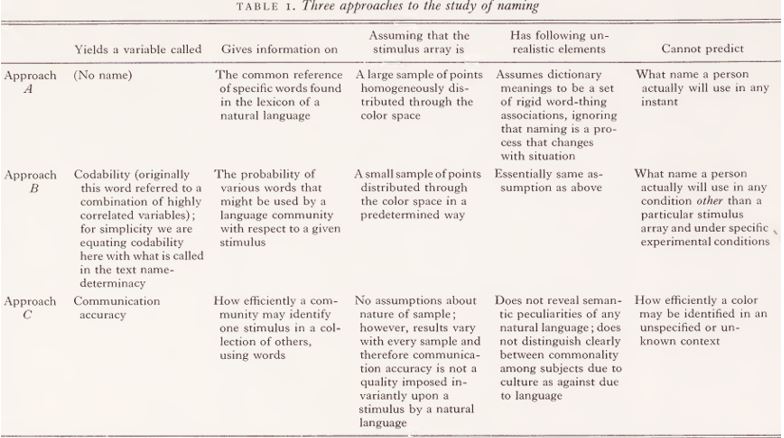
CONTEXTUAL DETERMINANTS IN COMMON NAMING
 المؤلف:
ERIC H. LENNEBERG
المؤلف:
ERIC H. LENNEBERG
 المصدر:
Semantics AN INTERDISCIPLINARY READER IN PHILOSOPHY, LINGUISTICS AND PSYCHOLOGY
المصدر:
Semantics AN INTERDISCIPLINARY READER IN PHILOSOPHY, LINGUISTICS AND PSYCHOLOGY
 الجزء والصفحة:
543-30
الجزء والصفحة:
543-30
 2024-08-25
2024-08-25
 1169
1169
CONTEXTUAL DETERMINANTS IN COMMON NAMING
The insight gained through the application of Approach B still gives an inaccurate picture of how the naming of phenomena proceeds. The structure of the name maps might induce us to believe that the English word red can only be used for a very few colors (the focus of the region ‘ red ’); and that as we move away from the focus the word would always have to be qualified as for instance yellowish-red, dirty red, etc. However, when one refers to the color of hair, or the color of a cow, or the skin color of the American Indian the word red is used without qualifiers. Conversely, the physical color which is named brownish-orange when it appears in the Munsell Book of Colors, and red when it is the color of a cow, may be called ochre when it appears on the walls of a Roman villa.
Quite clearly the choice of a name depends on the context, on the number of distinctions that must be made in a particular situation, and on many other factors that have little to do with the semantic structure of a given language per se; for example, the speaker’s intent, the type of person he is addressing himself to, or the nature of the social occasion may easily affect the choice of a name.
Only proper names are relatively immune from these extra-linguistic determining factors. But although the attachment of the name Albert Einstein to one particular person remains completely constant, it implies that in instances such as these the most characteristic aspect of language is eliminated, namely the creative versatility - the dynamics - and it may well be due to this reduction that proper names are not ‘felt’ to be part of a natural language. Once more we see that there are usually no direct associative bonds between words and physical objects.
It is also possible to study empirically the naming behavior that is specific to a given physical context. This was first done by Lantz and Steffire (1964), who used a procedure which we may call Approach C. In this method subjects are instructed to communicate with each other about specific referents. There are several variants for a laboratory set-up. The easiest is as follows: two subjects are each given an identical collection of loose color chips. The subjects may talk to each other but cannot see each other. Subject A chooses one color at a time and describes it in such a way that subject B can identify the color chip. For instance, subject A picks one color and describes it as ‘the color of burned pea soup’. Subject B inspects his sample and makes a guess which color the other subject might have picked; the experimenter records the identification number of both colors and measures the magnitude of the mistake (if any) in terms of the physical distance between the colors.1 If this procedure is done on a sufficiently large number of subject-pairs one may statistically reduce individual competence factors and come up with a measure, called communication accuracy, that indicates how well each of the colors in the particular context presented may be identified in the course of naming behavior.
Note that Approach C, leading to the estimation of communication accuracy, no longer indicates exclusively the nature of the relationship between particular words and objects and is thus somewhat marginal to the problem of reference. For instance, a given color chip, say a gray with a blue-green tinge, may obtain a very low communication accuracy score if it is presented together with fifty other grays, greens, blues, and intermediate shades, but a very high score if it is presented with fifty shades all of them in the lavender, pink, red, orange, and yellow range. Although this approach emphasizes the creative element of namipg, it probably does not distinguish between the peculiar semantic properties of one natural language over another. The difference between the three approaches is summarized in Table 1.
1 This is possible if we choose a linear stimulus array with perceptually equidistant stimuli as, for instance, described by Lenneberg, 1957.

 الاكثر قراءة في Semantics
الاكثر قراءة في Semantics
 اخر الاخبار
اخر الاخبار
اخبار العتبة العباسية المقدسة


